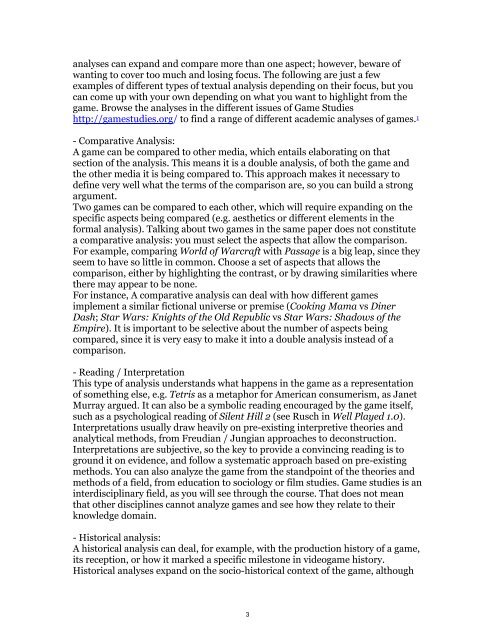MITCMS_300F11_GameAnaGuide
MITCMS_300F11_GameAnaGuide
MITCMS_300F11_GameAnaGuide
You also want an ePaper? Increase the reach of your titles
YUMPU automatically turns print PDFs into web optimized ePapers that Google loves.
analyses can expand and compare more than one aspect; however, beware of<br />
wanting to cover too much and losing focus. The following are just a few<br />
examples of different types of textual analysis depending on their focus, but you<br />
can come up with your own depending on what you want to highlight from the<br />
game. Browse the analyses in the different issues of Game Studies<br />
http://gamestudies.org/ to find a range of different academic analyses of games. 1<br />
- Comparative Analysis: <br />
A game can be compared to other media, which entails elaborating on that <br />
section of the analysis. This means it is a double analysis, of both the game and <br />
the other media it is being compared to. This approach makes it necessary to <br />
define very well what the terms of the comparison are, so you can build a strong <br />
argument. <br />
Two games can be compared to each other, which will require expanding on the <br />
specific aspects being compared (e.g. aesthetics or different elements in the <br />
formal analysis). Talking about two games in the same paper does not constitute <br />
a comparative analysis: you must select the aspects that allow the comparison. <br />
For example, comparing World of Warcraft with Passage is a big leap, since they <br />
seem to have so little in common. Choose a set of aspects that allows the <br />
comparison, either by highlighting the contrast, or by drawing similarities where <br />
there may appear to be none.<br />
For instance, A comparative analysis can deal with how different games <br />
implement a similar fictional universe or premise (Cooking Mama vs Diner <br />
Dash; Star Wars: Knights of the Old Republic vs Star Wars: Shadows of the <br />
Empire). It is important to be selective about the number of aspects being <br />
compared, since it is very easy to make it into a double analysis instead of a <br />
comparison. <br />
- Reading / Interpretation <br />
This type of analysis understands what happens in the game as a representation <br />
of something else, e.g. Tetris as a metaphor for American consumerism, as Janet <br />
Murray argued. It can also be a symbolic reading encouraged by the game itself, <br />
such as a psychological reading of Silent Hill 2 (see Rusch in Well Played 1.0). <br />
Interpretations usually draw heavily on pre-existing interpretive theories and <br />
analytical methods, from Freudian / Jungian approaches to deconstruction. <br />
Interpretations are subjective, so the key to provide a convincing reading is to <br />
ground it on evidence, and follow a systematic approach based on pre-existing <br />
methods. You can also analyze the game from the standpoint of the theories and <br />
methods of a field, from education to sociology or film studies. Game studies is an <br />
interdisciplinary field, as you will see through the course. That does not mean <br />
that other disciplines cannot analyze games and see how they relate to their <br />
knowledge domain.<br />
- Historical analysis:<br />
A historical analysis can deal, for example, with the production history of a game, <br />
its reception, or how it marked a specific milestone in videogame history. <br />
Historical analyses expand on the socio-historical context of the game, although <br />
3


